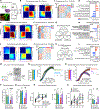Major-depressive-disorder-associated dysregulation of ZBTB7A in orbitofrontal cortex promotes astrocyte-mediated stress susceptibility
- PMID: 40516534
- PMCID: PMC12210276
- DOI: 10.1016/j.neuron.2025.05.023
Major-depressive-disorder-associated dysregulation of ZBTB7A in orbitofrontal cortex promotes astrocyte-mediated stress susceptibility
Abstract
Heightened activity in the orbitofrontal cortex (OFC), a brain region that contributes to motivation, emotion, and reward-related decision-making, is a key clinical feature of major depressive disorder (MDD). However, the cellular and molecular substrates underlying this dysfunction remain unclear. Here, we performed cell-type-specific profiling of human OFC and unexpectedly mapped MDD-linked epigenomic features (including genetic risk variants) to non-neuronal cells, revealing significant glial dysregulation in this region. Characterization of MDD-specific chromatin loci further identified ZBTB7A-a transcriptional regulator of astrocyte reactivity-as an important mediator of MDD-related alterations. In rodent models, we found that Zbtb7a induction in astrocytes is both necessary and sufficient to drive stress-mediated behavioral deficits, cell-type-specific transcriptional/epigenomic signatures, and aberrant OFC astrocyte-neuronal communication in male mice-an established MDD risk factor. These findings thus highlight essential roles for astrocytes in OFC-mediated stress susceptibility and identify ZBTB7A as a critical and therapeutically relevant regulator of MDD-related OFC dysfunction.
Keywords: ZBTB7A; anhedonia; astrocyte-neuron communication; astrocytes; chronic social defeat stress; epigenomics; major depressive disorder; orbitofrontal cortex.
Copyright © 2025 The Author(s). Published by Elsevier Inc. All rights reserved.
Conflict of interest statement
Declaration of interests I.M. and S.L.F. are co-inventors on a submitted patent application entitled “Treatment of major depressive disorder by inhibition of zinc finger and BTB domain-containing protein 7A (ZBTB7A) using miRNAs.”
Figures





References
-
- Kessler RC, Berglund P, Demler O, Jin R, Koretz D, Merikangas KR, Rush AJ, Walters EE, and Wang PS (2003). The epidemiology of major depressive disorder: results from the National Comorbidity Survey Replication (NCS-R). Jama 289, 3095–3105. - PubMed
-
- Rolls ET (2019). The orbitofrontal cortex and emotion in health and disease, including depression. Neuropsychologia 128, 14–43. - PubMed
MeSH terms
Substances
Grants and funding
LinkOut - more resources
Full Text Sources
Medical
Molecular Biology Databases

